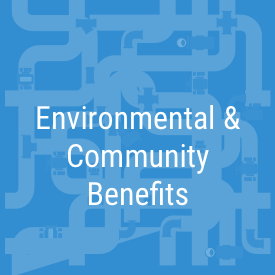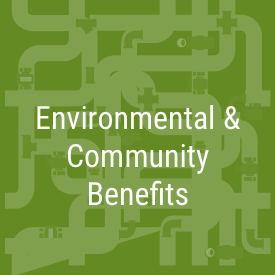This project helps restore and maintain healthy fish populations, especially steelhead, by improving fish passage and habitat. Sites may include Alamitos Creek at Almaden Lake and County of Santa Clara-owned Ogier Ponds, where human-made creek alterations disrupt fish migration. Project D4, which includes coordinating and partnering with other external parties, incorporates studies of streams throughout the county to determine what and where habitat improvements will most benefit steelhead. These studies can be used by regional partners to implement complementary habitat enhancements.
The project also continues funding to place instream gravel, boulders, large wood, or other features to enhance fish habitat at appropriate locations. By adding natural stream features such as large wood, we can create habitat to provide refuge during fish migration, prolonged drought, or extreme rainfall events. Additionally, habitat restoration can improve ecosystem function and increase resiliency to climate change. By restoring natural functions, issues such as water quality may be less exacerbated and native species can continue to flourish and adapt.








See Environmental & Community Benefits section for complete description of Key Performance Indicators (KPIs).
KPI #1: (Planning and design for creek/lake separation)
- On May 11, 2021, the Board certified the Final Environmental Impact Report. Click here to read the report.
- The planning phase of the project was completed in 2019.
- Valley Water will close out the design phase by June 30, 2024.
KPI #2: (Partially construct creek/lake separation)
Ogier Ponds: This project is a conservation measure for the Anderson Dam Seismic Retrofit Project (ADSRP).
- A Master License Agreement (MLA) to facilitate Valley Water’s access and planning study investigations on Santa Clara County Parks land is in development.
- Feasible alternatives evaluation for the planning study is underway.
- Design is expected to begin in Spring 2025.
- Construction will be coordinated with ADSRP completion (currently 2032).
KPI #3: (Fish passage improvements)
In FY23, Valley Water selected the Moffett fish ladder on Stevens Creek for fish passage improvement. Work has begun on the planning study report and the Moffett fish ladder was investigated during 2023-2024 winter conditions. We are also developing working relationships with local interests and resource agencies. Design is scheduled to begin in FY25. This fish barrier is ranked seventh in Valley Water’s fish passage barrier prioritization report for Stevens Creek (Stevens Creek Fish Passage Remediation Prioritization: August 2021). Poor fish passage performance at this facility results from debris clogging in the ladder and poor attraction flows at the entrance. Replacing this barrier will improve a minimum of 1,100 feet of the Stevens Creek corridor for steelhead passage.
In October 2021, the City of San José, in partnership with Valley Water, completed the construction of a new interim pedestrian bridge, replacing the Singleton Road low-water crossing at Coyote Creek. Valley Water provided $1.0 million in cost-share funding to the city for construction. Valley Water also provided the city with project design services and permitting assistance. The low-water crossing was a barrier to fish passage and its removal increased migratory fish access to about 17 miles of upstream Coyote Creek area with better, cold-water habitat. Valley Water will continue to monitor the project through 2031.
KPI #4: (Steelhead stream study update)
In FY23, Valley Water selected Guadalupe Creek, Alamitos Creek, and Arroyo Calero for a new fish passage barrier removal prioritization study. The selection followed consultations with various units, including Environmental Mitigation Monitoring, Environmental Planning, Operations and Maintenance, and Environmental Support. Staff is in the process of developing an on-call services contract to provide support for the study and potential future projects. An internal stakeholder meeting was held in March to develop prioritization criteria. Site reconnaissance for potential fish impediment sites, based on the California Department of Fish and Wildlife Passage Assessment database, is scheduled to begin in May.
KPI #5: (Habitat enhancement projects)
In August 2022, Valley Water completed the construction of the large woody debris and gravel augmentation (LWDGA) project to improve the fish habitat along Uvas Creek in Gilroy. The project is designed to increase instream habitat diversity, shelter complexity, and the amount of instream shelter at three sites along Uvas Creek. The design of Site 1, located approximately 1,200 feet downstream of Santa Teresa Boulevard, consisted of an engineered log jam (ELJ) of rootwad logs on the right bank intended to create hydraulic complexity and increase shelter cover and complexity. The ELJs for Sites 2 and 3, located 1,500 feet and 600 feet upstream of Miller Avenue, included a bar apex jam at each site designed to cause channel bifurcation and increase habitat complexity.
Staff is coordinating with the Anderson Dam Tunnel Project team to implement a fish habitat project as part of the Live Oak Restoration Reach. The Live Oak Restoration Reach is an approximately 2,600-foot section of Coyote Creek along the Live Oak Area of Anderson Lake County Park that will be enhanced for steelhead spawning and rearing with features such as spawning gravel augmentation, large wood and boulder placement, and vegetated gravel bars. This will enhance 2.59 acres of creek habitat and will support a long-term gravel augmentation program. These enhancements, which are in the area of Coyote Creek downstream of Anderson Dam with the coolest water temperatures, are anticipated to provide important benefits to steelhead and their critical habitat for both spawning and summer and winter rearing. The designs for the Live Oak Restoration Reach are consistent with watershed plan recommendations to enhance aquatic habitat for fisheries in Coyote Creek (neet.ecoatlas.org), build from the Phase 1 Study of Santa Clara County Steelhead Streams to Identify Priority Locations for Gravel Augmentation and Large Woody Debris Placement (Balance Hydrologics 2018), and have been developed to ensure compatibility with Live Oak Area recreation and the final post-ADSRP physical, hydrologic, and hydraulic conditions of this reach.
Project Modification: January 2023
On January 24, 2023, the Valley Water Board of Directors (Board) held a formal public hearing and approved modifying KPI#2 to “Partially fund the construction of one (1) creek/lake separation project in partnership with local agencies.” The modification was necessitated due to construction cost escalations across the Safe, Clean Water Program impacting the program’s financial health.
The Board also changed the project selections for KPI #1 and KPI #2. The Board selected the Almaden Lake Improvements Project to deliver KPI #1 to complete planning and design for one (1) creek/lake separation. Since previously selecting the Almaden Lake Improvements Project to be constructed under KPI #2 in 2021, Almaden Lake Improvements Project construction cost estimates have nearly tripled, making project construction unfeasible. As a result, the Board selected the Ogier Ponds Project to deliver KPI #2 to partially fund the construction of one (1) creek/lake separation project in partnership with local agencies. The Ogier Ponds Project is now part of the Anderson Dam Seismic Retrofit Project (ADSRP) as a conservation measure to help offset some of that project’s impacts. As part of ADSRP, the Ogier Ponds Project construction is funded by more sources than just the Safe, Clean Water Program, which helps reduce the financial impact on the Safe, Clean Water Fund.
April 2024
Key Performance Indicators (FY22-36)
-
Complete planning and design for one (1) creek/lake separation.
-
Partially fund the construction of one (1) creek/lake separation project in partnership with local agencies.
-
Use $8 million for fish passage improvements by June 30, 2028.
-
Update study of all major steelhead streams in the county to identify priority locations for fish migration barrier removal and installation of large woody debris and gravel as appropriate.
-
Complete five (5) habitat enhancement projects based on studies that identify high priority locations for large wood, boulders, gravel, and/or other habitat enhancement features.
Benefits
-
Improves habitat and passage for steelhead and other native fish within Santa Clara County watersheds
-
Contributes to required mitigation for environmental impacts of reservoir and recharge operations and countywide Stream Maintenance Program
-
Maintains investment in earlier habitat improvements
-
Addresses climate change
Geographic Area of Benefit
Countywide
About the Safe, Clean Water and Natural Flood Protection Program
In November 2020, voters in Santa Clara County overwhelmingly approved Measure S, a renewal of Valley Water’s Safe, Clean Water and Natural Flood Protection Program.
The program was first passed by voters in 2000 as the Clean, Safe Creeks and Natural Flood Protection Plan, then again in 2012 as the Safe, Clean Water and Natural Flood Protection Program. The renewal of the Safe, Clean Water Program will continue to provide approximately $47 million annually for local projects that deliver safe, clean water, natural flood protection, and environmental stewardship to all the communities we serve in Santa Clara County.
While evaluating ways to improve the 2012 program, Valley Water gathered feedback from more than 21,000 community members. That helped Valley Water create the six priorities for the renewed Safe, Clean Water Program, which are:
Priority A: Ensure a Safe, Reliable Water Supply
Priority B: Reduce Toxins, Hazards and Contaminants in our Waterways
Priority C: Protect our Water Supply and Dams from Earthquakes and Other Natural Disasters
Priority D: Restore Wildlife Habitat and Provide Open Space
Priority E: Provide Flood Protection to Homes, Businesses, Schools, Streets and Highways
Priority F: Support Public Health and Public Safety for Our Community
Each year, Valley Water prepares a report providing a progress update for each of these program priorities, along with fiscal year accomplishments.
To ensure transparency and accountability to the voters, the ballot measure also created an Independent Monitoring Committee, appointed by the Santa Clara Valley Water District Board of Directors. The Independent Monitoring Committee annually reviews the program’s progress to ensure the outcomes are achieved in a cost-efficient manner and reports its findings to the Board. Additionally, the IMC also reviews each proposed 5-year implementation plan prior to its submittal for Board approval.
In addition, the program requires three independent audits.




